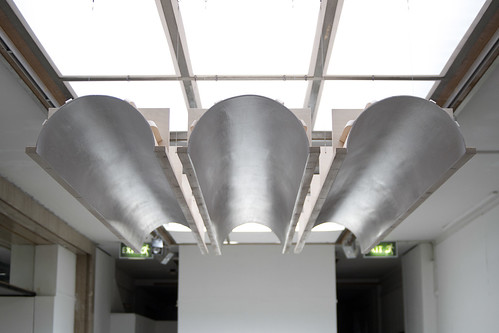
Rosebay willow herb is a ruin-loving plant, the weed of decayed modernity. [...] It is known too as fireweed; the plant is a marker of disruption and decay, and grows on charred ground after forest fires have destroyed all other vegetation. So attuned is it to such sites that if it does not appear in the wake of a fire it is sometimes sown as to start the process of organic regeneration - it is a plant of hope as much as ruination. At the seminary, it seems to stand sentinel in rows about the buildings, as if gaily awaiting some ritual or celebration by which the complex might be brought back to life.
Dillon, 2011
I thought I would start with the beautiful words of Brian Dillon from his new fiction, Sanctuary. I finished reading the book on the train back from the NVA's book launch of To Have and To Hold at the Edinburgh International Book Festival. Both books take inspiration from, what many would argue is Gillespie, Kidd & Coia's greatest achievement, St. Peter's Seminary, in Cardross. What differentiates the books is Dillon's is one of fiction, as with the quote, only referring to the "the seminary", but without a doubt, St. Peter's is source of the fantastically rich and descriptions language of a ruined seminary on the outskirts of a large city (i.e. Glasgow).
The story, although a little close to home, describes the girlfriend of an artist/ filmmaker/ general eclectic sort on a search for her lover who has disappeared amongst the ruins of "the seminary". For the record, my work focuses on St. Bride's, and I'm single, so it is definitely not biographical. Joking, and general story aside, Dillon paints an overwhelming description of the artists fascination with the seminary. For me, this work of fiction is, in relation to the descriptions of the seminary, a work of non-fiction, and punctuates this "fascination" certain demographics have with architecture from the Modern Movement. Another quote from Dillon succinctly explains the draw such structures have:-
He found his way inside the main block because this was the space, in the countless photographs taken by previous visitors and architecture enthusiasts, that had first convinced him there was something to be explored, some story or image that was not yet exhausted by the bare facts of the seminary's history and the aesthetic banality of its present ruination. The place, he told her, was too good to be true: it was a modern cliché on a monumental scale, and in its very obvious romanticism there must be some remainder, a quality that was still invisible to those who had been there before him.
Where I diverge from our missing protagonist, is this quality he seeks that has not been found by those who have visited before. I feel my practice, began in a very similar fashion, finding out about St. Peter's through photographs on websites such as the Hidden Glasgow Forums, but as my practice developed and focus turned towards the non-ruined St. Bride's, I began to question my own perceptions of these structures. Drawing on a wide range of sources, beyond simply site visits, perhaps removed some of the romance from the research, and introduced a pragmatism to my practice which prevented me from getting easily swept away.
The New RC Pavilion, is a physical manifestation of my own rationalisation of the forms which constitute the very particular branch of Gillespie, Kidd & Coia's Modernism. There is romance within the sculpture, floating above your head, with a handling of materials that is contradictory to the dogmas of the Modern Movement. I'm detached yet completely involved with the subject matter, with the empty space below the pavilion a platform for the open-ended discussion that has taken place throughout my Masters.
I'm content in the knowledge that it may say everything or nothing about our relationship with these icons of a nostalgia that is both complete fiction and non-fiction.
Nothing exists anymore but everything is like before, more true than natural, disengaged of every fragilities and imperfections that time put in stone and plaster.
Augé
No comments:
Post a Comment